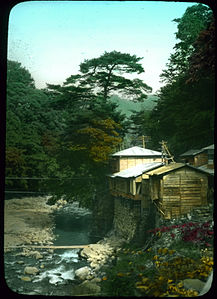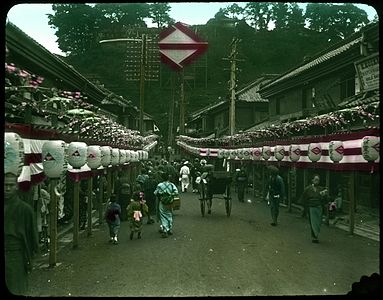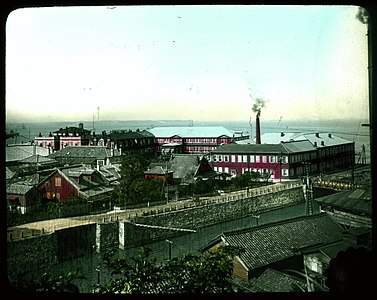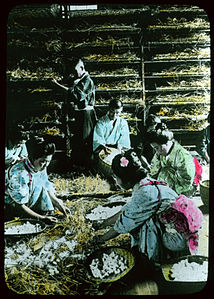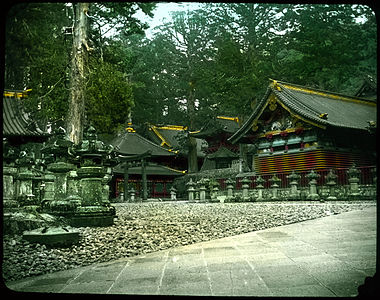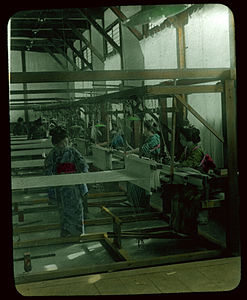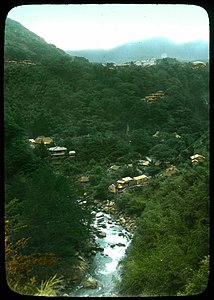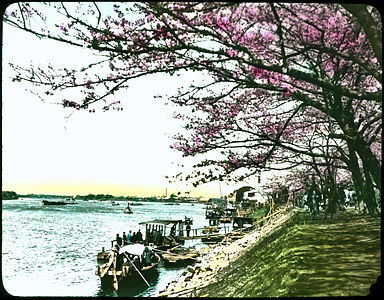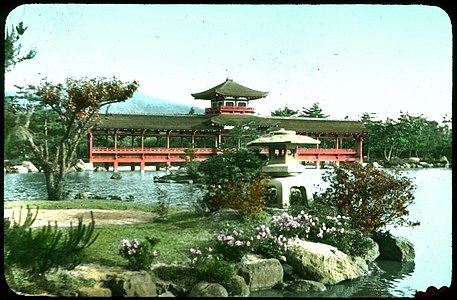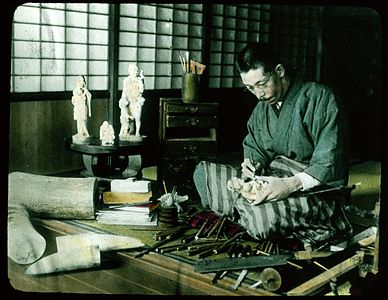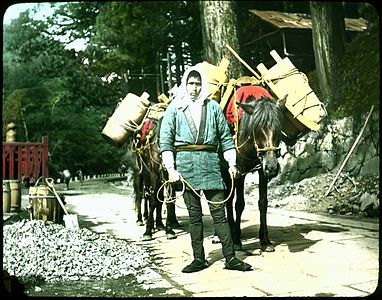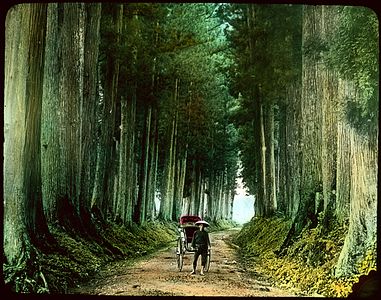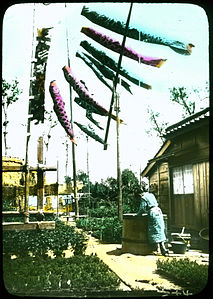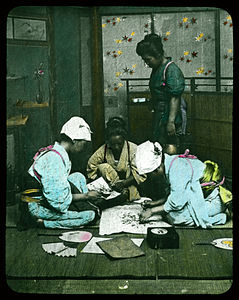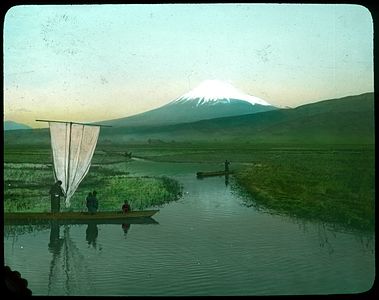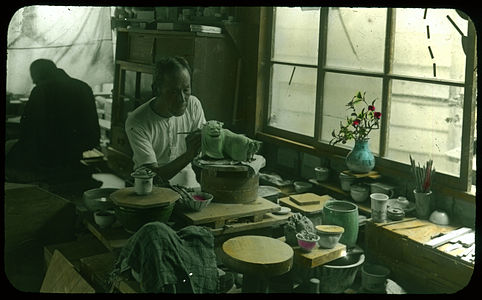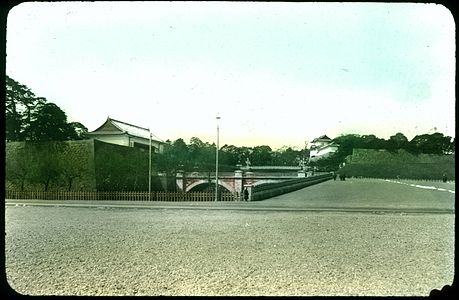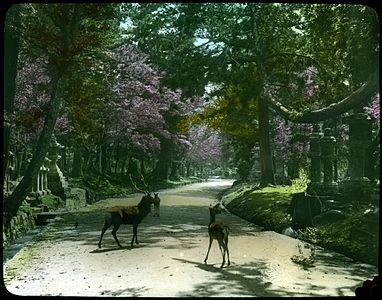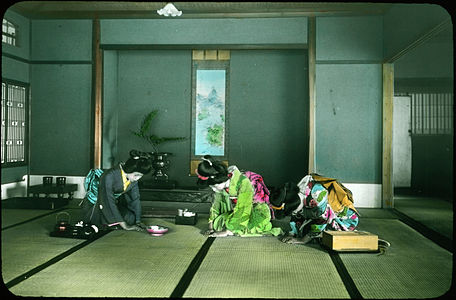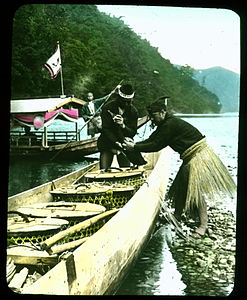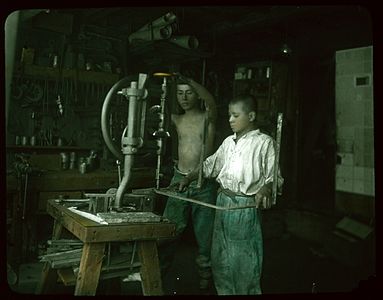Yokohama photographs
Yokohama photographs also known as Herbert Geddes collection or Life in Japan, ca. 1910 is a collection of photographic glass-plate transparencies collected by Canadian Herbert Geddes in the beginning of the 20th century. The collection is stored in the University of Victoria.[1]
Herbert Geddes[edit]
Herbert Geddes (1877–1970) worked for G.R. Gregg and Company in Vancouver and Winnipeg. He was sent by the company to Japan, and lived in Yokohama for ten years, from 1908 to 1918. He worked as a manager for the company to mid-1950s.[1]
Collection[edit]
Glass-plates depicting life in Japan were sold to foreigners between 1868 and 1912. Plates in Geddes' collection include "scenery, street scenes, workers, farming, fishing, silk production, stone carvers, wood carvers, metal workers, potters, and artists".[1] Glass-plates were colored by hand. As noted by Clémence Leleu for PEN online, "This was a very popular practice, which, in the specific case of glass-plate photographs, made it possible to add density and variable contours to the subject through the use of transparency and variations in brightness."[2][3]
Gallery[edit]
-
(Dashi) parade
-
Buildings built up on stone walled riverbank with trees in background
-
Close-up of ornamental building embellished with gold.
-
Crowd-filled street lined with banners and lanterns
-
Curved red wooden bridge over river; forest in background
-
Curved stone bridge in rural area
-
Eight young women in Kimonos, four in wooden boat on water, four on bank beside boat, two of them holding open parasols
-
Examining Silk-thread (19955514911).jpg
-
Factories, external view
-
Family in traditional attire having portrait taken in garden against fence
-
Feeding Silk-Worms
-
Four women smiling and leaning through openings in lattice work
-
Gathering Cocoons
-
Gathering Mulberry Leaves
-
Group of buildings set among trees; ornamental stone wall in front
-
Group of deer feeding on lawn in wooded garden; stone monuments and summer house in mid-ground
-
Group of women and one man watching young woman working on large embroidery
-
Hand-weaving in factory
-
Harbour of city; jetty with steamboats in foreground; other boats and buildings in background
-
Hatching of Silk-Worm Eggs
-
High stone embankments above river; line of trees on top of each embankments; tall building with temple roofs on one side; another building hidden behind trees on other side
-
Houses in the woods, river in foreground
-
Interior shot of two geishas asleep in bedding on floor mats; musical instrument, fan and implements for tea ceremony nearby
-
Iris garden beside water; wooden bridge to small roofed island; two women in Kimonos on bridge and one standing among flowers
-
Japanese cherry trees in blossom on grassy bank beside waterways; people strolling under trees; docks and boats with people
-
Japanese people (including some men in western dress) strolling through paved grounds among large stone lanterns; temples and pagoda
-
Japanese people in local attire hiking through mountains
-
Lake side resort
-
Large building (temple?) in wooded setting
-
Large Silk Factory
-
Long red wooden covered bridge with ornamental roof; woods on either side of bridge, woods and mountain behind; water and landscaped point of land with flowers in foreground
-
Machine-weaving in factory
-
Making wooden barrels
-
Making wooden barrels
-
Man beginning to carve lantern from block of stone
-
Man carving ivory statue of mother and child
-
Man in local attire with loaded packhorses
-
Man painting parasols; painted lanterns in background
-
Man painting shells
-
Man using handsaw on tree trunk
-
Man with rickshaw on tall tree lined dirt road
-
Man working over large wooden tub; rows of plants in pots all around; fish streamers flying overhead
-
Men carving wooden furniture of intricate design
-
Men making clay moulds for giant masks
-
Men preparing for sumo wrestling outdoors
-
Men trimming edge of a plank
-
Mother and children outside rural hut with waterwheel
-
Mount Nantai and Daiya River
-
Old woman in shed heating substance in black pot
-
Old woman with raised grinding stone; two little girls carrying babies on their backs looking on
-
Open air ceramic shop
-
Painting vases. (slide cracked)
-
Papering Eggs for Next Year
-
People in boats on waterways through rice fields; snow-covered mountain in background
-
People in special attire, with lanterns, posing for photograph
-
People in traditional attire and men in uniforms standing outside building with gilt trim
-
People in traditional attire in park
-
People on street in traditional dress outside building decorated with large banners, lanterns and signs
-
People wading in sea; fisher with hand net; boats in background
-
Potter at work on lion figure
-
Potter making vase on wheel
-
Reeling Silk in Large Skeins
-
Reeling Silk in Small Skeins
-
Rice being poured into a wooden mechanical hopper
-
River in mountains; raised bank with houses on one side; Japanese children on side of river
-
Road, sidewalk, pavement; stone walls and bridge, lamp standards; buildings and trees in background
-
Rural women in local attire carrying large baskets on their backs
-
Series of red wooden gateways; stone animals on pedestals between first and second gateway
-
Snow-covered mountain (Mt. Fuji?) wreathed with clouds; low ground leading down to water in foreground
-
Sorting Silk
-
Sorting Silk
-
Taking Silk From Cocoons
-
Tea implements in centre of richly furnished room
-
Temple and houses on hill over valley filled with trees
-
Three deer standing on road in (cemetery) garden; large flowering cherry trees, evergreens and stone monuments
-
Three women with fans, musical instrument and a table set with food
-
Three women with tea implements
-
Tinsmith at work
-
Two (priests?) outside shrine
-
Two boats on river, a passenger boat being poled and a fishing boat filled with lidded open work baskets
-
Two boats with cloth canopies being rowed along river; wooded mountain on one side; rushing water in foreground
-
Two boys using drill press
-
Two men landing boat on beach
-
Two women in traditional dress posing outside house in tiny ornamental garden
-
Two women winnowing rice and man pounding rice flour
-
Two young women in Kimonos, one standing, one seated on wooden bench outside open greenhouses filled with blooming flowers
-
Unidentified building with some yellow roofs with pond and trees (including flowering plum trees)
-
Village on a bay; fields and hillside in foreground
-
Weaving (silk) on hand loom
-
Woman in traditional dress holding open parasol and carrying baby on her back
-
Woman separating rice from chaff with steel comb
-
Women at work with children watching
-
Women harvesting rice
-
Women planting rice
-
Women preparing rice field in mud
-
Women working on hillside; rice fields and village below
Further reading[edit]
- Meiji no Nihon: Yokomana shashin no sekai: Saishoku arubamu. Yokohama-shi Yurindo, 1990. (Meiji Japan in tinted album: the world of Yokohama photographs)
References[edit]
- ^ a b c "Herbert Geddes collection - University of Victoria". uvic2.coppul.archivematica.org. Retrieved 9 April 2022.
- ^ "Images of Japan on Glass Plates". Pen Magazine International. 24 June 2021. Retrieved 9 April 2022.
- ^ "Herbert Geddes' "Life in Japan" Collection: Hand-Coloured Glass Transparencies of the Meiji-Era". The Public Domain Review. Retrieved 9 April 2022.


